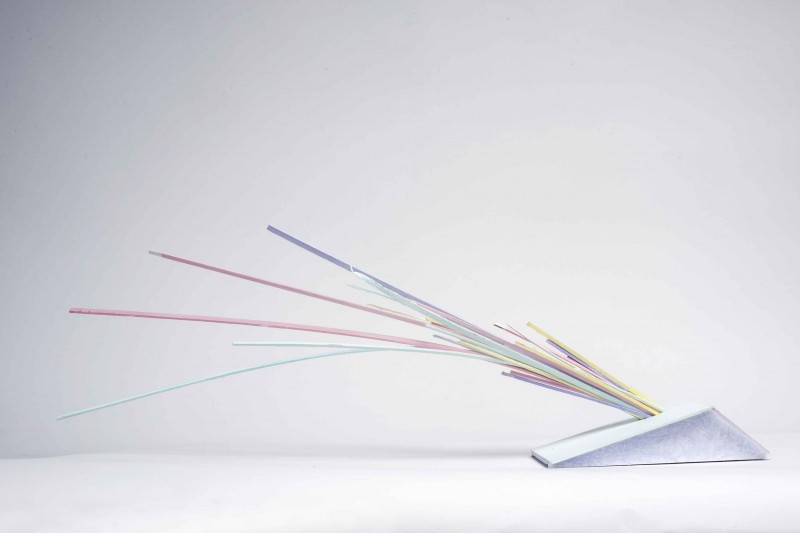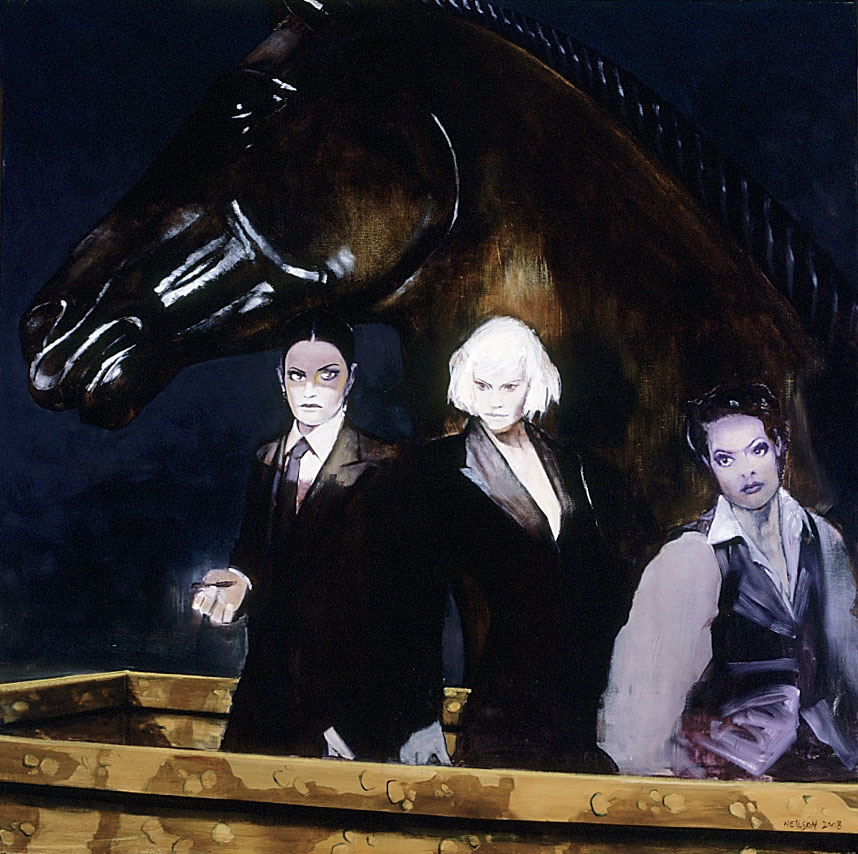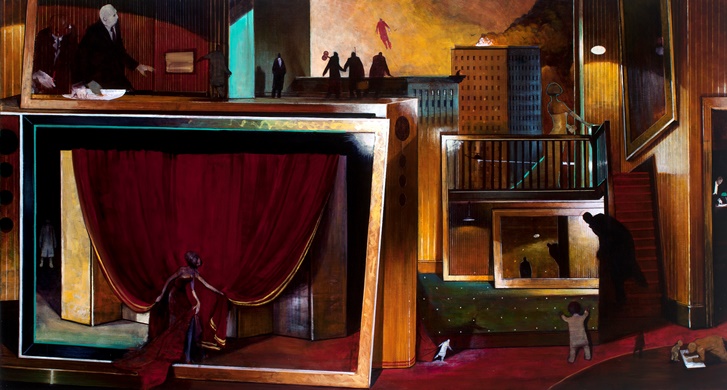Peter Neilson – Artist Feature
In News November 22, 2021

Peter Neilson is known for his enigmatic large scale paintings featuring interlacing narratives, mysterious characters and multiple shifting perspectives. His expansive works explore variations in perspective and utilise the cinematic language of film noir to suggest dark urban narratives. In the following Q&A Peter Neilson shares with us his creative approach and artistic inspirations and influences.
Did the Melbourne lockdown affect your time in the studio? Have you adopted a new daily routine or is it business as usual?
The pandemic allowed for more hours in the studio because of less need for my partner and myself to assist in grandchild care; we missed their company. An ‘often-broken routine’ of reading in the morning, studio time in the afternoon, then evenings watching moving images was before, during, and continues to be after the pandemic, about my speed.
 Early morning from the studio window
Early morning from the studio window
Tell us how you approach painting? Do you begin with preparatory drawings or studies or does the painting evolve as you paint directly to canvas?
Working on my large paintings in my studio, ‘alone’, I am an “artist” and I am a “public.” I paint. I assess. I wait, for a “frisson of ecstasy “ (Aragon), which creates some new (intuitive?) idea, something that I have never thought. I paint it on the canvas. I assess again, and wait again, for another “event” (Lazzarato). When I “sense” it, I act on that possible “percept” (Bergson) and position it on the canvas. I wait again for another “interval between received and performed movements.” (Bergson); and so it goes . . . As I work, my painting comes to me as something wholly new; that is, the painting becomes something I was not expecting; something that literally has made a life of its own and, once made has no other purpose than to be in the world as “a work” and “the work” of art. – From my catalogue essay Elsewhere 2020.
Also,
My own paintings, more often than not, are becoming uncertain, interrupted, discontinuous, struggling. I want to see the politics of the painting itself: what images survived, which one’s didn’t, to see how the work may have ‘finished’ on/at another ‘point’. I want to see the paintings, not finished to ‘the point,’ but after abandonment, as a possible ongoing ‘working’ site. As I have written elsewhere the problems surrounding the use of charcoal, eraser and paper to draw in the beautiful ‘en plein air’ landscape are not those to be solved when painting a large studio canvas mediating different ideas, marks and possibles of an image of competing temporalities, distances, perspectives. It is, for me, to acknowledge, through embedded unsureness, a solidarity with an uncertain, incomplete and weary world. I respect the unfinished ‘fact’ and negotiate the unfinished, abandoned ‘solution’. I want questions not answers. – From my catalogue essay En Pointe 2020.
Your work spans from complex, loaded, large-scale paintings, to landscape and still life drawings, to abstract sculpture in paper, which we’ve seen in recent years. What influences your decision to move from one medium to another? Is there an overlap between these works?
I sculpt for reasons other than I draw and I draw and sculpt for reasons other than I paint. The lack of an ‘obvious’ relationship between my art arising out of, and within, the different mediums, is an insistence on the singular, the individual, the hand made; in other words, an insistence on the individual mark in a world of diminishing possible futures, imposed by predictive analogues, and, therefore, a subjugation of individuality by stealth.
 Untitled 2017 cardboard, glue, paint 20 x 58 x 9 cm
Untitled 2017 cardboard, glue, paint 20 x 58 x 9 cm
What is your earliest creative memory?
My earliest creative memory came late. It was, when making art never work to a deadline. Deadlines are the work and aim of the Arts Industry.
Do you have a favourite artist or artwork? How does it inspire you?
Many favourite artists and artworks (in random order): Degas, all of it; Kitaj; Braque’s late Studio Series; St. Barbara’s 15th century unknown sculptor (NGV); Tiepolo; the wild ride of the Chinese Southern Sung Dynasty style (especially the Flung Ink style); on and on . . .
The inspiration is that they involved themselves as totally as they could in making aesthetic choices and as little as they could in the interminable logistics of the Art World. Art is a long game (Rembrandt is six hundred years old, and getting older. Damian Hirst is not, yet).
What is your studio set up like?
My studio is my studio.
It is not Picasso’s studio where he buys a many-roomed house (or swaps it for a still life), fills it with his work, locks the door, buys another, repeats the process . . .
And it is not Braque’s studio(s), more’s the pity
“The conception of his studios is grand and noble . . . bare and neat and pure. There is no outward show of luxury, but the luxury is everywhere: luxury is in the peace of Braque’s life, in its spaciousness, quiet and convenience. Life seems to center around him, and everything is planned to help his work. He has solved the material problems of creation.”

Do you listen to music or podcasts when working in the studio?
I listen, but sometimes I have shut everything down to work through a visual problem that just won’t lie down.
I listen to the podcast gossip and I choose from a lifetime of serious listening to serious music from Bach to Mahler to Schoenberg, to Beethoven’s Sixth and Mozart’s Requiem to George Jackson by Dylan, etc. then on to Takemitsu, Davis and, and Coltrane (but only when I feel strong enough. He’s heavy). Finally, late at night with a whiskey, Satie, Debussy, Brubeck.
Can you share with us some influences in your work? Does it stem from political news, films, books?
I read and look, not for influences, as confirmation. My reading continues by my wanting, not to illustrate a philosophical position, so much as to ensure, as much as possible, that what work I make isn’t philosophically and historically dead even before I put it up on the walls to be exhibited.
In the Stock Rooms
 The foreboding: Helen, Andremarche and Cassandra (shipped out of Troy as war booty) 2008 oil on linen 100 x 100 cm
The foreboding: Helen, Andremarche and Cassandra (shipped out of Troy as war booty) 2008 oil on linen 100 x 100 cm Stances 6 (on the front line) 2013 oil on board 24.5 x 19.5 cm
Stances 6 (on the front line) 2013 oil on board 24.5 x 19.5 cm The Tin Pot is North Fitzroy 2019 charcoal and pastel on paper 55.5 x 76 cm
The Tin Pot is North Fitzroy 2019 charcoal and pastel on paper 55.5 x 76 cm Unveiling stone walls (so others can blow whistles in the wind) 2012-13 oil on linen 100 x 185 cm
Unveiling stone walls (so others can blow whistles in the wind) 2012-13 oil on linen 100 x 185 cm Over there (and far away) 2013 oil on board 6 x 14 cm
Over there (and far away) 2013 oil on board 6 x 14 cm
Image at top: The whistle blower 2017-18 oil on linen 150 x 300 cm
